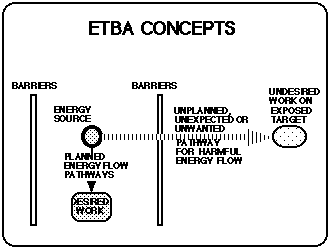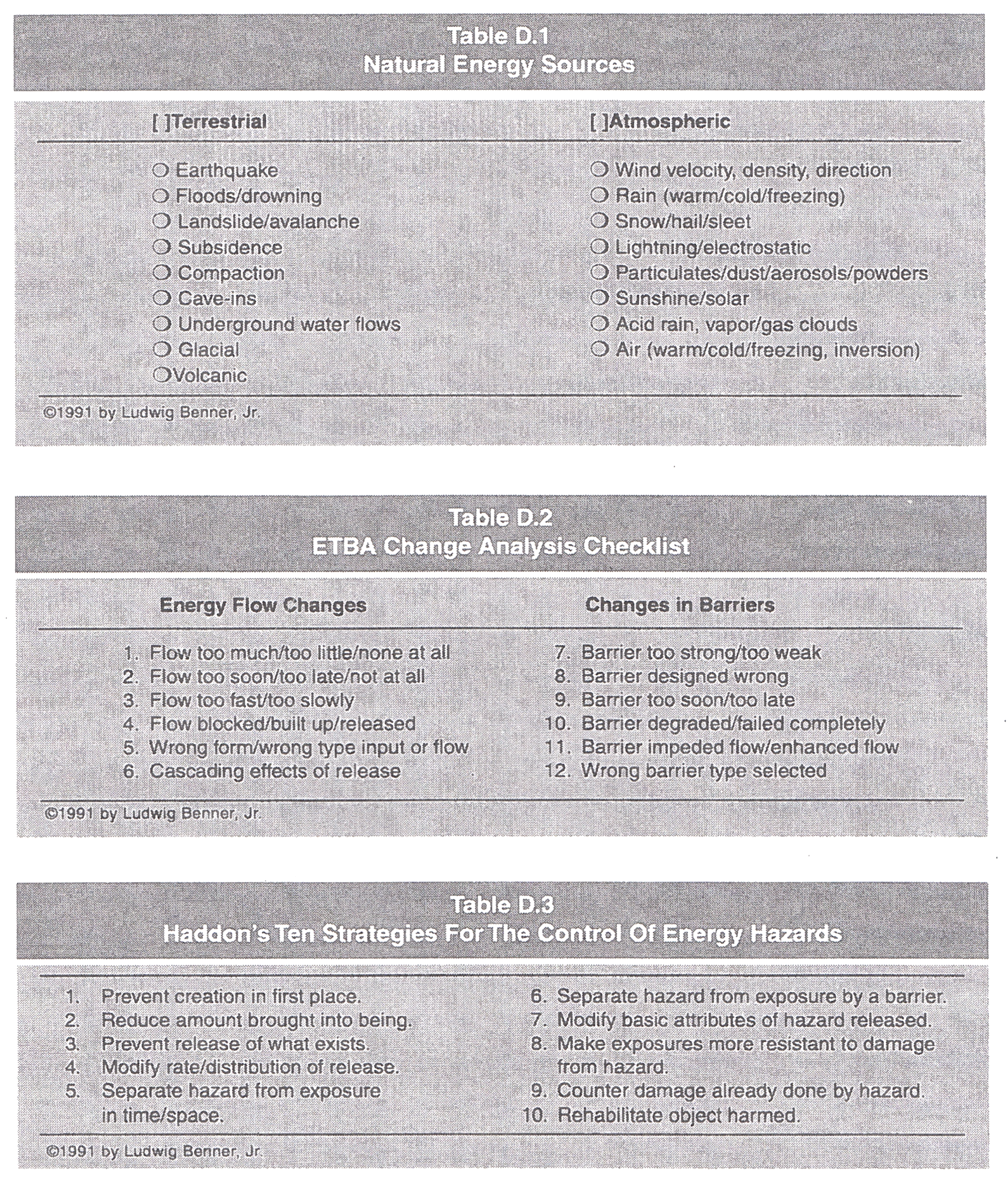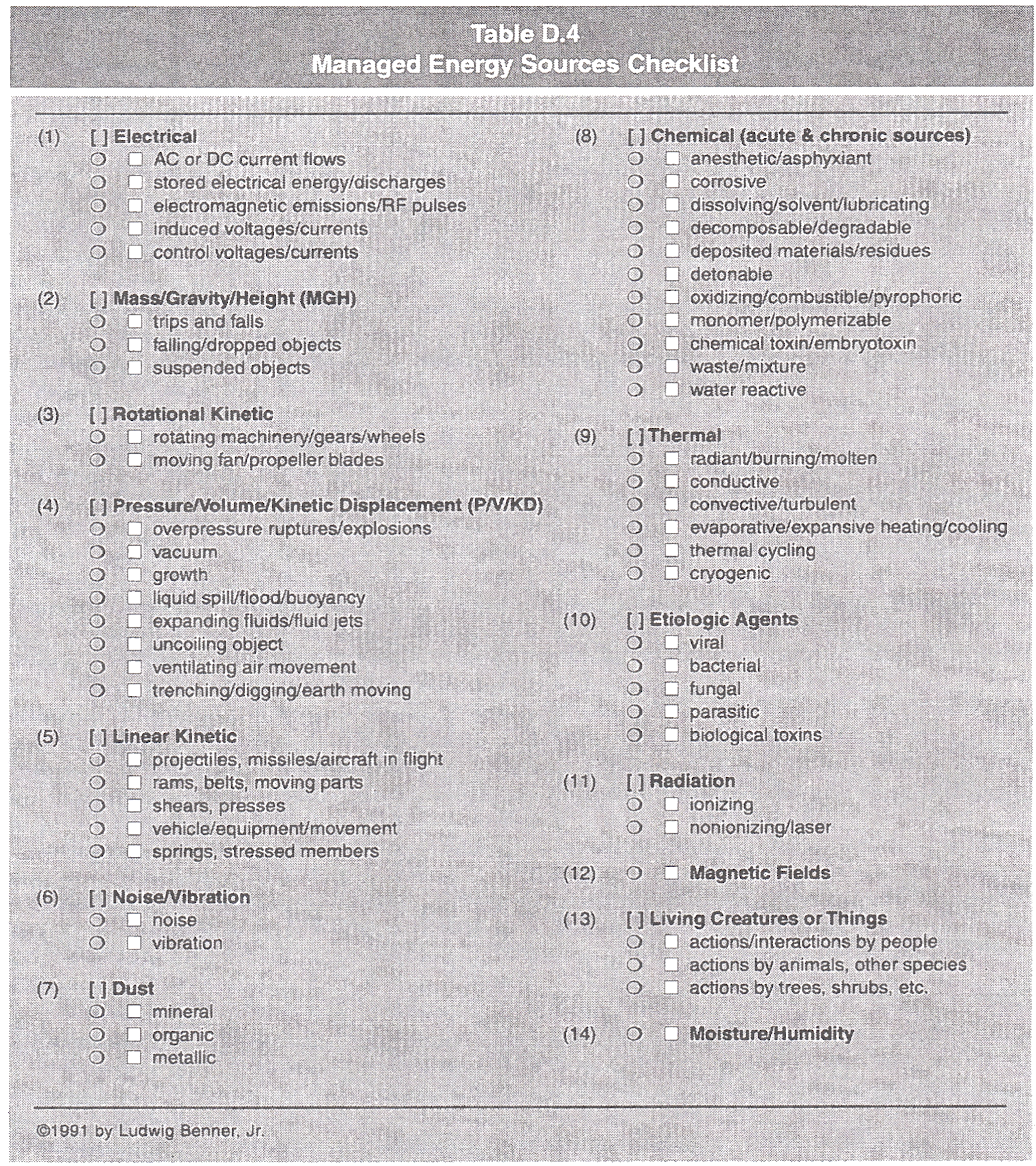11

FINDING BBs WITH ETBA
A continuing challenge to episodic incident investigators is trying to find data to transform into building blocks (BBs) to develop a description of what happened. Energy Trace and Barrier Analysis (ETBA) is a technique for tracking energy sources and flows during an episode, observing where they do work and what work they do, and transforming that data into investigation input data BBs.
The general ETBA method is to
- identify energies going into and acting within the system
- track each energy and its actions during the episode
- identify the barriers and controls acting on the energies
- identify the effects of the energy actions
- transform the actions into BBs
Procedures for this technique are presented in this Guide.
INTRODUCTION
The Energy Trace and Barrier Analysis (ETBA) method can be used to develop a more detailed understanding of energy exchanges that occurred during an episodic phenomenon. The technique helps investigators avoid overlooking behaviors that might not otherwise be noticed.
This technique approaches the development of investigation input data BBs by tracing the flows of energy into, within, and out of a system or component involved in a phenomenon. It is based upon the premises that energy flows introduce changes in an activity, system or component which, if understood, can be predicted and controlled. ETBA documents energy flows by methodically tracing energy movements within activities, systems or components, and across interfaces, to identify behaviors that influenced the progression of BBs during the episode being investigated.
OBJECTIVE
The objective of this Guide is to present the procedure used to identify energies involved in an episodic phenomenon, document their behaviors as input data BBs for use on STEP-MES Matrixes, and help identify additional data requirements.
APPLICABILITY
ETBA can be used at any stage of an investigation to explore changes and help develop hypotheses about what might have happened.
DATA REQUIRED
The procedure can accommodate any observed or documented data about energies involved in any episode. It requires knowledge about about kinds of energies, their attributes and behaviors; the energies present during an episode; the expected course of the energy flow through the system involved with the episode; and the energy flow out of the system.
DATA SOURCES
The procedure uses
1. an energy source checklist (see Table 5-2)
2. any observed or documented data from any source that describes or indicates energy sources or energy flows.
Where data are acquired from things, inferences about the presence of energy sources and flows are usually acceptable.
Each type of energy, summarized in Table 5-2, may need to be considered individually from the perspective of the phenomenon being investigated if it is present during the process. Energies present also need to be considered in the context of any energy control strategy or strategies that may exist (See Guide 8.) The operation needs to be analyzed at the input /use /output level for each energy type to determine if energy barriers or controls address realistic potential control problems and satisfactorily control them.
ETBA requires detailed familiarity with the operation or system. ETBA often requires the services of someone who really knows the operation and who can trace energies and barriers /controls thoroughly.
ETBA PROCEDURE
| The ETBA procedure relies on input-operation-output analytical thought processes. Someone or something introduces energy into the phenomenon being investigated (input.) After it is introduced, the energy does something in the system (operation.) After it does something in the system (output) , left over energy may exit the system (output.) If the interaction(s) required all the energy available, it may leave behind evidence of its interactions. The residual effects of energy exchanges may be recorded as changes in things or on recordings of measurement devices, or as observations of motion or displacement by people, for example. These are the "tracks" that must be observed before BBs can be developed for a STEP-MES Matrix.
Figure 5-1 Energy Flows and Barrier Roles

|
After identifying an energy source that was present or introduced into the system, and where it is present in the system, the procedure is to trace what the energy did or does during the phenomenon of interest. This requires identification of the "targets" of energy flows for each energy source. For each energy type, the flow must be traced to each transfer or use point, and then traced into any branches that flow from that point. Then each physical or procedural barrier to the energy must be considered to determine what changes occurred or might occur. When episodes are being investigated, ETBA helps define BBs by asking certain questions about each energy type. Figure 5-2 is a list of those thought starter questions.
Figure 5-2 ETBA Checklist

For an undesired outcome to occur, there must be an energy source with a released flow of energy to a target in the absence of adequate barriers. The flow or transfer of energy follows some path between the energy source and the target or component of the operation being protected.
Remember: the objective is to develop BBs, where the energy is the actor, what the energy did is the action, and what the energy acted on is included in the descriptor. The descriptor for an energy flow BB should include the pathway.
COMMENTS
ETBA is one of the more practical and informative investigation tools available to investigators. It is essential when applying deductive reasoning to observations of objects to discover the actions which changed them during a phenomenon. The mental discipline required to trace the energy flow and the results produced by energy flows during a phenomenon can be demanding, relying heavily on visualization techniques, but the rewards from its use are usually so great that the effort justifies it. The main precaution is to ensure that the energy trace data is transformed into the BB format to allow integration with other data provided by other investigation tools.
This framework can also be used for analyzing human energy inputs, and tracing the pathway followed by human energy initiation. In a hand injury episode, for example, the ETBA method can provide very useful BBs for Matrix arrays by tracking the energy inputs, barriers, energy flows, and resultant injury.
ETBA is also helpful for investigation of episodes before they occur. Figure 5-3 describes the procedure for using it for investigations. The first step, defining the system operation, can utilize the STEP-MES Matrix method for displaying who or what does what to produce the desire outputs during system operations or during an episode. The the ETBA procedure can be applied predictively to the system operation to discover potential desirable or undesirable episodes.
Figure 5-3 ETBA Procedure Flow Chart

Figure 5-4. provides lists of Natural Energy Sources, an ETBA Change Analysis Checklist, Haddon's Ten Strategies For The Control Of Energy Hazards, and A Managed Energy Sources Checklist,to provide thought starters for investigators. These lists were reproduced from my 1992 "Guide 2 Accident Investigation" publication by Fire Protection Publications, written to accompany a training film series. Some of its content has been overtaken by events, but the energy tables are stil useful.
Figure 5-4. Investigators' ETBA Thought Starters



Go to Guide:
0
1
2
3
4
5
6
7
8
9
10
11
![]()
![]()